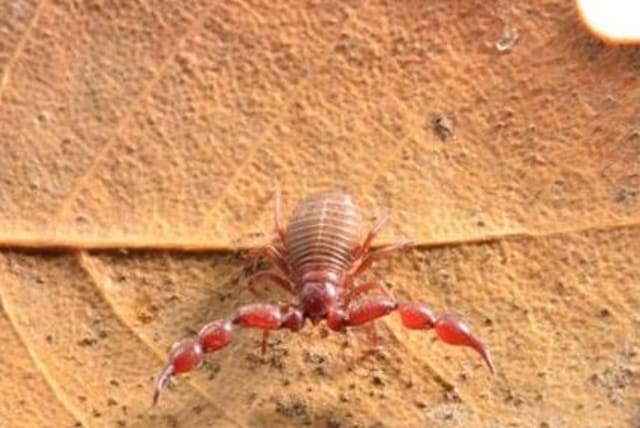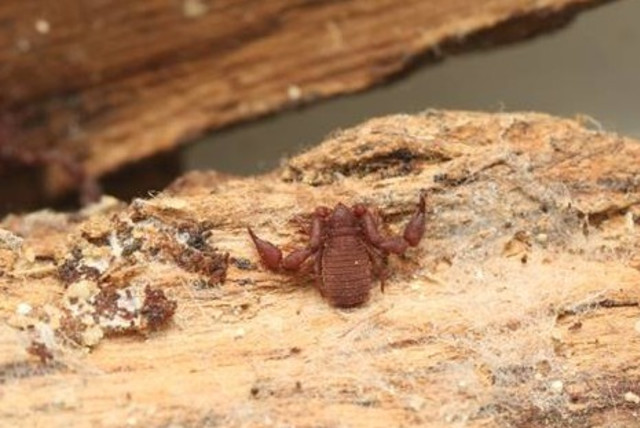Pseudoscorpions of Israel: Two new family records discovered by Hebrew University entomologists

Pseudoscorpions aren't harmful to humans, and are even beneficial because they feed on caterpillars, flies, ants, beetle larvae, and carpet- and book-lice larvae.
Overturning a rock, one wouldn’t want to discover a scorpion or even a pseudoscorpion, – a tiny scorpion-like arachnid. However, when the finder is an entomologist (insect expert), it’s an exciting career experience.
A new Hebrew University of Jerusalem study has unveiled two previously undiscovered families of pseudoscorpions in Israel, called syarinidae and cheiridiidae. Located where three continents meet, this country’s unusual biodiversity has undergone systematic revision.
Before the Hebrew University study, Israeli pseudoscorpions were believed to consist of 12 families, 26 genera, and 52 species, including several subspecies. But now the bug catalog has been expanded to include 61 pseudoscorpion species belonging to 28 genera and 14 families.
This pioneering research includes the introduction of the first illustrated identification key, based on structural characters and accompanied by distribution maps. Both of the new families have a cosmopolitan distribution that includes much of the Mediterranean region. The findings significantly enhance our understanding of regional biodiversity, offering crucial resources for forthcoming ecological, taxonomical, and conservation endeavors.
The discovery was presented in the journal Taxonomy in the article, “Pseudoscorpions of Israel: Annotated checklist and key, with new records of two families.” The research, conducted by Dr. Sharon Warburg, Dr. Efrat Gavish-Regev, and colleagues at Hebrew University’s National Natural History Collections, provides a crucial update to the understanding of the pseudoscorpion species in Israel.
The authors said that the significance of their research goes beyond the academic realm by offering valuable insights into the biodiversity of the region and providing a foundation for future studies in ecology taxonomy and conservation. “The annotated checklist and key, with their meticulous documentation and visual aids, are expected to become essential resources for researchers, students, conservation organizations, and enthusiasts interested in pseudoscorpion taxonomy,” they write.
Pseudoscorpions, also known as “false scorpions” or “book scorpions,” are tiny creatures that are not harmful to humans like real scorpions – and are even beneficial because they feed on caterpillars, flies, ants, beetle larvae, and carpet- and book-lice larvae. They are rarely noticed due to their small size, despite being common in many environments. When they are noticed, especially inside homes, they are often mistaken for small spiders or ticks.They have a flat, pear-shaped body, and eight pincer-like claws, with five to seven sections each. Their claws look like those of scorpions and are two to eight millimeters in length.
What is this species?
A pseudoscorpion is yellowish-tan to dark brown and has eight legs with five to seven segments each; the number of fused segments is used to distinguish among families and genera. Its abdomen is short and rounded in the back instead of becoming a segmented tail and stinger, like real scorpions. Pseudoscorpions spin silk from a gland in their jaws to make disk-shaped cocoons for mating, molting, or surviving cold weather.
Situated at the crossroads of three continents, Israel boasts a distinctive fauna, influenced by both Palearctic and Afrotropical zoogeographic origins. During the past six decades, systematic revisions and the discovery of new species have made the existing key to pseudoscorpions in Israel outdated.
“The newly released checklist offers a contemporary perspective on the pseudoscorpion species in the region, complete with distribution maps and a groundbreaking illustrated identification key based on morphological characters,” the authors wrote.
Jerusalem Post Store
`; document.getElementById("linkPremium").innerHTML = cont; var divWithLink = document.getElementById("premium-link"); if (divWithLink !== null && divWithLink !== 'undefined') { divWithLink.style.border = "solid 1px #cb0f3e"; divWithLink.style.textAlign = "center"; divWithLink.style.marginBottom = "15px"; divWithLink.style.marginTop = "15px"; divWithLink.style.width = "100%"; divWithLink.style.backgroundColor = "#122952"; divWithLink.style.color = "#ffffff"; divWithLink.style.lineHeight = "1.5"; } } (function (v, i) { });

